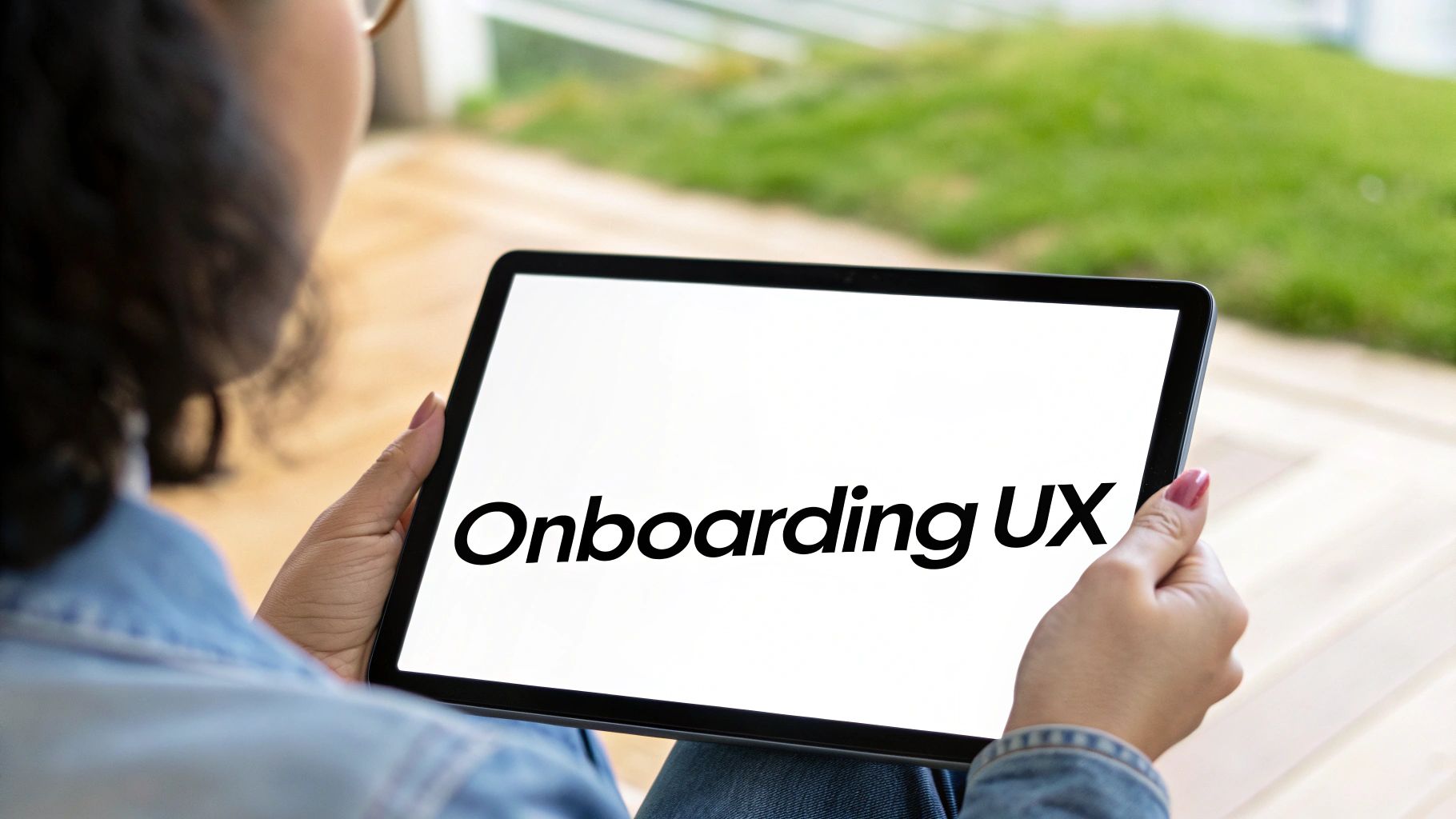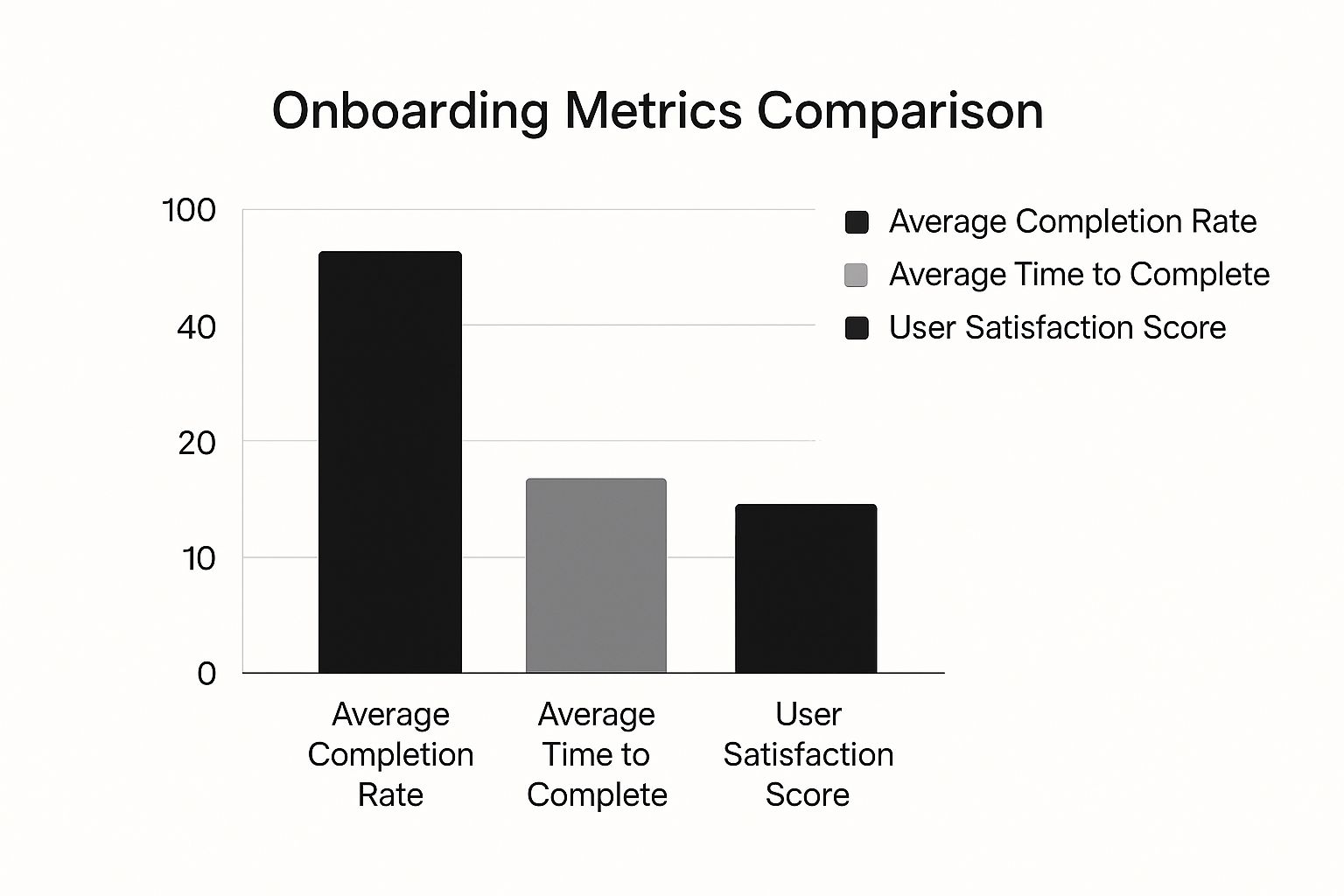Why Most Onboarding UX Design Still Falls Short

It’s a common challenge for product teams: their onboarding UX design might be unintentionally causing users to leave, sometimes right after their first interaction. These initial moments are incredibly important, as people often form lasting impressions of a product within seconds, sometimes without even consciously realizing it.
This quick judgment means that even minor flaws in the early user experience can have significant negative consequences. The importance of good onboarding UX design is clear. Recent studies show that 34% of users may not return after just one unsatisfactory onboarding experience. Moreover, almost 74% of users give up on the onboarding process before finishing it, often because the steps are too complicated or the instructions aren't clear. You can learn more about user onboarding statistics to understand the scope of this issue.
Unseen Barriers in Early User Experience
So, what are these subtle issues that can discourage users, even if the product itself is excellent? They frequently arise from common, yet often missed, problems in onboarding UX design:
- Information overload: Presenting too many features, excessive text, or numerous choices all at once can overwhelm someone new to the product.
- Vague value proposition: If users don’t quickly understand how the product benefits them or solves their specific problems, they are less likely to invest more time.
- Lack of immediate wins: Failing to guide users to an early "aha!" moment—where they experience the product's core value—can leave them feeling unfulfilled and unmotivated.
- Generic experiences: Onboarding that feels impersonal or doesn't adjust to the user's stated needs or existing knowledge often fails to connect.
These seemingly minor points can add up, creating a frustrating first impression instead of a welcoming one, which directly affects how many users stick around.
The Strategic Importance of First Impressions
This is why many successful companies now view onboarding UX design not just as a list of features to show, but as a core part of their business strategy. They recognize that these initial interactions are exceptionally important for fostering long-term engagement and customer loyalty. Grasping the details of onboarding is especially vital in distributed work environments; you can find best practices for remote onboarding to help navigate this.
The psychological factors at play during these first encounters are strong. People naturally look for clarity, want to see progress, and desire to feel competent quickly. When an onboarding UX design successfully addresses these basic human needs, it builds essential early trust and encourages users to explore the product further. In contrast, an experience that causes confusion or seems too difficult can make users want to disengage almost immediately.
Ultimately, numerous real-world examples show that fixing what might appear to be small onboarding issues can lead to considerable, measurable gains in user retention and overall product success. It’s about carefully crafting those first few interactions to make sure they are positive, setting the stage for a good and lasting relationship with the user.
The Hard Numbers Behind Onboarding UX Design Investment

A poor first impression can silently drive users away, but the reverse is also true: investing in onboarding UX design is a smart financial move. It's not just about fixing problems; it’s a calculated decision that can yield significant returns. That's why forward-thinking businesses see onboarding not as a necessary expense, but as a key driver for lasting growth.
The numbers paint a clear picture of the financial benefits of good onboarding UX design. When companies focus on user experience, with onboarding as a key component, the return on investment (ROI) can be remarkable. Studies show that every $1 spent on UX can bring back $100, which is an ROI of 9,900%. This happens because a strong onboarding process reduces user confusion, lowers the number of people who give up, and helps users quickly understand what makes the product useful. Find more details on UX ROI from UXCam.
Beyond Completion Rates: Tracking Real Business Outcomes
Smart companies know that to justify spending on onboarding UX design, they need to look past basic completion numbers. They dig into conversion funnels during onboarding to pinpoint exactly where users might be leaving or, more positively, where they hit important activation milestones. For example, they might monitor how many users finish a crucial first task after going through an onboarding guide.
Using retention cohorts offers insights over a longer period. By comparing different user groups who went through varied onboarding experiences, businesses can see a direct connection between better onboarding UX design and users remaining active for more weeks or months. This provides solid evidence linking onboarding effectiveness to continued user engagement.
Onboarding as a Revenue Multiplier
This detailed approach is why progressive companies view onboarding UX design not as an expense, but as something that boosts revenue. For example, if an A/B test reveals that a simpler onboarding step leads to 20% more users trying out a feature, and this in turn results in a 5% increase in premium upgrades, the monetary benefit is clear. These are not just tweaks to the user experience; they directly generate income.
The clear link between good onboarding and financial results highlights its role in long-term customer lifetime value (CLV). A smooth, helpful first experience does more than just prevent users from leaving; it lays the groundwork for a more valuable customer relationship. This holds true for various products, from SaaS platforms to mobile applications, where the first welcome greatly influences the total financial return from every user.
Building Onboarding UX Design That Actually Works

Recognizing the substantial financial benefits of a thoughtfully designed onboarding UX prompts an important question: How do you create one that truly connects with users? Effective onboarding isn't about showcasing every single feature. Instead, its main goal is to help users reach their first success moment as smoothly and quickly as possible. This initial win is crucial for shaping how users see your product and encouraging them to stick around.
To get a clearer picture of what successful onboarding involves, consider how key performance indicators interact. The image below illustrates data on average completion rates, average time to complete, and user satisfaction scores for onboarding processes.
 This visual demonstrates that higher completion rates and satisfaction often go hand-in-hand with an optimized time to complete. This suggests that efficiency is just as vital as being thorough in onboarding UX design.
This visual demonstrates that higher completion rates and satisfaction often go hand-in-hand with an optimized time to complete. This suggests that efficiency is just as vital as being thorough in onboarding UX design.
Mastering Core Onboarding Techniques
Achieving this balance relies on a few fundamental approaches. A key method is progressive disclosure. This means instead of bombarding new users with all options at once, you introduce features and information step-by-step, right when they need them. It's like learning a new instrument; a good teacher introduces notes and chords gradually, not the entire songbook on day one.
Another important aspect is forging an emotional connection through your design. This can make the onboarding journey more engaging and memorable. You can achieve this with welcoming messages, personalized elements, or even small animations that celebrate when a user accomplishes a task. When users feel valued and guided, they're more inclined to invest time in learning your product.
To help understand how different onboarding elements contribute to user success, the table below compares some essential components and their typical effects.
Key Onboarding UX Elements Comparison Comparison of essential onboarding elements and their impact on user completion rates
| Element | Purpose | User Impact | Implementation Difficulty | Retention Boost |
|---|---|---|---|---|
| Progressive Disclosure | Reveal features gradually to prevent overwhelm | Reduces cognitive load, makes learning feel manageable | Moderate | High |
| Emotional Connection | Make the experience memorable and engaging | Users feel understood, supported, and more connected to the product | Moderate | Moderate to High |
| Guided Tours/Tooltips | Provide direct instruction on features | Helps users learn specific functionalities, offers immediate help | Low to Moderate | Moderate |
| Skippable Steps | Allow experienced users to bypass known information | Respects user's time and existing knowledge, reduces friction | Low | Moderate |
| Contextual Onboarding | Adapt experience based on user data or signup source | Delivers a more relevant and personalized initial experience | Moderate to High | High |
| Interactive Walkthroughs | Guide users by having them complete key actions | Active learning, helps users achieve first success moment quickly | Moderate | Very High |
This comparison highlights that a mix of strategies, tailored to your product and users, often yields the best results. No single element is a silver bullet, but combined, they create a supportive and effective initial experience.
Structuring the User's First Experience
A well-thought-out framework for your onboarding should always find a middle ground between providing information and allowing user independence. While guided introductions and helpful hints are valuable, users also appreciate the space to explore on their own terms. This involves offering clear routes to value while also permitting exploration and personal discovery.
It's also vital to design for varied user motivations. Not everyone approaches your product with identical objectives or the same level of technical skill.
- Contextual onboarding: Adjust the experience based on how a user signed up or the initial details they share.
- Role-based paths: If your product caters to different types of users, offer distinct onboarding journeys for each.
- Skippable steps: Let users who are already familiar with similar tools bypass introductory material they don't need.
Avoiding Common Onboarding Pitfalls
Even seasoned designers can encounter typical challenges when creating first-time user experiences. A common error is concentrating too much on what the product can do, rather than why it's beneficial to the user. The onboarding process should clearly communicate the product's value and steer users towards achieving their particular aims.
Other frequent pitfalls include:
- Overly long or complex flows: Users have limited attention; keep it brief and focused.
- Lack of clear calls to action: Users need to know exactly what to do next.
- Ignoring mobile users: Your onboarding must work smoothly on all devices.
- Not A/B testing: Always test and refine your onboarding based on user actions and feedback.
Successfully managing these components is key to developing an onboarding UX design that not only keeps users but also prepares them for lasting success with your product. Getting this balance right is a fundamental part of effective SaaS growth strategies. If this topic interests you, you might find more insights here: Mastering SaaS Growth Strategies for Sustainable Success.
Crafting Your Strategic Onboarding UX Design Framework

Instead of focusing on individual parts, a truly effective onboarding UX design is built on a strong strategy that always puts real user needs first. Quick fixes might give you temporary boosts, but a strategic outlook fosters long-term user connection by thoroughly understanding what motivates and holds back your users right from the start.
This foundational understanding helps create an onboarding experience that not only welcomes users but also effectively steers them toward achieving their objectives with your product.
Understanding User Motivations and Constraints
The path to a great onboarding UX design starts with meaningful user research focused specifically on the first-time user. It’s more than just knowing who your users are; it’s about understanding why they’ve chosen your product at this particular time and what problems they are trying to solve. Are they looking for a quick answer, checking out different options, or are they ready to learn a new tool?
This deeper knowledge allows you to connect your business goals with their actual requirements. For instance, if research reveals that new users are often puzzled by industry-specific terms, your onboarding process can proactively simplify language or provide explanations as needed. This strategic connection ensures your onboarding UX design directly addresses user difficulties, making their first interaction with your product more pertinent and helpful.
Mapping the Critical User Journey
Once you have a better grasp of your users, mapping their critical journey during the onboarding phase is a vital step. Picture this as drawing a detailed map that notes every action, emotion, and potential difficulty a new user might face.
This mapping process helps uncover hidden opportunities where a minor adjustment can significantly improve the experience, or impactful intervention points where timely assistance can prevent user frustration. For example, a journey map might show that users often get stuck when asked to import data. This information enables you to design a more supportive step at that exact point, perhaps by offering a simple walkthrough or an option to "do it later." Identifying these crucial moments is fundamental for a proactive onboarding UX design.
Personalizing and Adapting the Flow
With a solid understanding of user motivations and their journey, you can then look into methods for personalizing onboarding experiences. The objective is to make each user feel individually addressed without bombarding them with too many choices or irrelevant details. For example, if a user signs up via a marketing campaign that highlighted a specific feature, the onboarding can introduce that feature early on.
This also means creating adaptive flows that respond smartly to various user situations and objectives. A successful onboarding UX depends heavily on the quality of the user interface. For more ideas on creating responsive and engaging interactions, you might explore the fundamentals of designing effective chat interfaces. Ultimately, an adaptive onboarding UX design means the experience feels adjusted and efficient for everyone—whether they're new to tech or a seasoned pro, using a desktop or a mobile device—guiding them smoothly to their initial success.
Why Companies Are Desperately Seeking Onboarding UX Talent
The strong emphasis on user retention and the complete customer journey has significantly increased the demand for skilled onboarding UX design professionals. Businesses understand that a user's first interactions with their product are critical, often determining long-term loyalty or quick departure.
The Shifting Landscape of User Experience Roles
This demand isn't surprising when considering the wider trends in user experience. Financial and hiring data highlight its growing importance. By 2025, a notable 70% of companies globally aim to hire at least one UX professional, with 20% planning to add three or more UX specialists. This significant hiring trend shows a clear recognition that proficient UX design, especially for initial user experiences like onboarding UX design, is essential for remaining competitive. You can find more detailed statistics here.
This growing awareness means companies are actively looking for individuals who can do more than just design user interfaces. They require experts capable of strategically developing the entire onboarding UX design process to promote user success and build loyalty from the very beginning. Consequently, career prospects and salary expectations in this specialized field are becoming more appealing.
What Companies Value in Onboarding UX Specialists
When businesses look for onboarding UX design talent, they are searching for a particular combination of skills. Beyond fundamental design abilities, they place high value on a thorough understanding of user psychology—what drives users, what creates difficulties, and how to guide them effectively to that "aha!" moment.
Furthermore, the capacity to use data is highly regarded. Companies want designers who can study onboarding funnels, pinpoint where users drop off, and continually refine the experience based on actual user behavior. This data-informed method changes onboarding UX design from a basic welcome into a significant factor for user activation and retention.
New Frontiers: Emerging Career Paths in Onboarding UX
The development of onboarding UX design is ongoing, and new career avenues are opening up at the meeting point of onboarding, growth, and data. Businesses are increasingly establishing roles that merge onboarding knowledge with skills in growth hacking, data science, and behavioral psychology. These professionals are responsible not only for welcoming users but also for deeply understanding their journey and refining every interaction to achieve maximum engagement and lifetime value.
These positions frequently concentrate on boosting user activation and long-term value, aligning directly with broader company growth strategies. You might find this interesting: Referral Program Best Practices for Sustainable Growth. This interdisciplinary focus indicates a mature comprehension of how vital a well-designed first experience, created through expert onboarding UX design, is for sustained growth in a competitive market.
Measuring What Actually Matters In Onboarding Success
Securing skilled onboarding UX design talent is a significant first step. However, to truly understand the impact of their efforts, we must look beyond surface-level numbers. Effective measurement of onboarding success considers both numerical performance and the actual user experience, ensuring that what is tracked genuinely leads to improvements.
Setting Up Insightful Onboarding Analytics
To get a clear picture of how your onboarding UX design is performing, tracking mere completion rates isn't sufficient. It's more beneficial to establish onboarding funnels that monitor key user behaviors. This involves identifying the critical actions users need to perform to grasp your product's main value—often referred to as the "aha!" moment. Following user progression through these stages shows not only who finishes onboarding but also how they interact throughout the process.
These funnels will naturally reveal drop-off patterns, which are extremely useful for pinpointing specific areas of difficulty within your onboarding UX design. For instance, if a large number of users leave the process when asked to integrate a third-party service, this is a strong indicator that the step might be too complicated, not clearly explained, or introduced too soon.
From Data to Design Improvements
Identifying these drop-off points is just the beginning; the next crucial step is to use this information to guide focused design enhancements. Instead of making assumptions, you can form educated guesses, or hypotheses, about why users face challenges at certain stages. For example, a high drop-off rate might indicate a need for more straightforward instructions, a simpler user interface, or perhaps breaking down a complex task into smaller, more digestible steps.
To confirm these hypotheses, running experiments such as A/B tests is vital. By comparing different versions of an onboarding flow, you can collect statistically sound data on what genuinely connects with users and boosts their progress. This ongoing cycle of measuring, analyzing, and experimenting is key to refining your onboarding UX design.
Advanced Measurement and Communication
For a more thorough understanding, consider segmenting users based on their performance during onboarding. Are users acquired through a specific marketing channel facing more difficulties? Do users with different stated objectives show varying completion rates? Customizing metrics for distinct user groups can uncover subtle insights that a general approach might overlook.
The following table outlines some vital key performance indicators (KPIs) that provide a fuller picture of how successful your onboarding process truly is.
Onboarding Metrics Dashboard Key performance indicators for measuring onboarding success with benchmarks and tracking methods
| Metric | Definition | Target Range | Tracking Method | Business Impact |
|---|---|---|---|---|
| Activation Rate | % of new users completing key "aha!" moment action(s) within X days | 60-80% | Product Analytics (e.g., Mixpanel, Amplitude) | Higher likelihood of long-term retention |
| Time to Value (TTV) | Median time taken for a new user to experience the core product value | < 15 mins | Event Tracking | Faster user engagement, reduced early churn |
| Onboarding Completion Rate | % of users who complete all defined onboarding steps | > 70% | Funnel Analysis | Indicates clarity and ease of initial steps |
| Drop-off Rate (per step) | % of users exiting onboarding at a specific step | < 5% per critical step | Funnel Analysis | Highlights friction points needing redesign |
| Feature Adoption (post-onboarding) | % of onboarded users using key feature Y within Z days | > 50% | Product Analytics | Shows onboarding effectiveness in driving behavior |
Tracking these metrics provides a solid foundation for understanding user behavior and the direct effects of your onboarding efforts.
Effectively sharing this data with stakeholders is just as important as collecting it. Use these metrics to construct persuasive, data-backed narratives that support design choices and clearly demonstrate the connection between a strong onboarding UX design and important business results, such as increased user retention. You might be interested in: Our comprehensive guide on how to reduce customer churn through strategies including better onboarding.
Key Takeaways
Gathering data on your onboarding UX design is an important first step. The real value, though, comes when these findings are put into practice. This means creating a clear plan to improve the first vital interactions users have with your product, effectively converting knowledge into real-world improvements.
Turning Insights Into Action for Your Onboarding UX Design
The initial step in this change is a thorough review of your current onboarding experience. This involves several key actions:
- Revisiting user journey maps.
- Analyzing the drop-off points identified in your metrics.
- Gathering qualitative feedback directly from users. Consider using practical checklists to ensure all aspects of the onboarding UX design, from the clarity of instructions to emotional engagement, are assessed.
This review will help you pinpoint specific areas ripe for improvement. For example, if data indicates users find a particular setup step difficult, that step becomes an immediate priority for redesign. This organized approach allows teams of any size to start making significant changes without feeling overloaded.
Prioritizing for Impact
With a list of potential improvements, the next task is prioritization. Not all changes produce the same results, so it's crucial to distinguish between:
- Quick wins—small adjustments that can offer immediate benefits.
- Strategic long-term improvements—changes that might require more resources but promise substantial impact. A simple framework could involve evaluating changes based on potential user impact versus the effort needed for implementation.
Gaining stakeholder agreement is also vital for continued investment in onboarding UX design. Presenting clear data on current performance, along with well-defined proposed solutions and their expected outcomes, can effectively show the value of these efforts. This ensures ongoing support for improving your user onboarding.
Measuring and Iterating for Growth
Ultimately, improving your onboarding UX design is a continuous process, not a one-off project. By setting clear success criteria and consistently monitoring key metrics, you can track progress and adjust your strategies. This iterative method ensures your onboarding evolves with your users' needs and your product’s development.
This focus on continuous improvement helps make your user onboarding experience a real competitive advantage. A well-crafted onboarding UX design doesn't just keep users; it actively contributes to measurable business growth by preparing users for long-term success and advocacy.
As you refine your onboarding UX design for maximum user success and growth, empower those satisfied users to become your biggest champions. Refgrow makes it easy to embed a powerful affiliate program directly into your SaaS product. Transform your user base into a growth engine with Refgrow!

